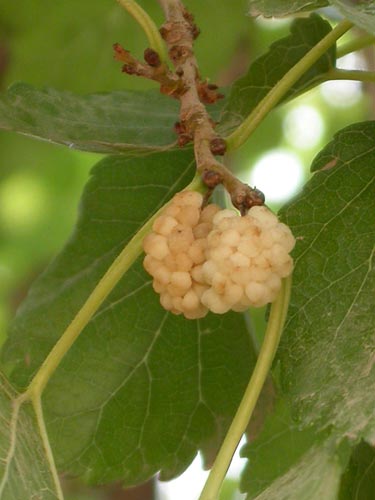Relatives
Morus alba L. - White mulberry.
Taxonomic position.
Family Moraceae Link, genus Morus L.Synonyms.
Morus indica L., M. tatarica L., M. italica Poir., M. taurica MB., M. pumila Balb., M. heterofilla Loud., M. tortuosa Audib., M. venosa Delile.Morphology and biology.
Latex-producing, dioecious plant. Deciduous tree or shrub, 4-15 m tall. Branches are thin, grey-brown. Leaves are 4-10 (12) cm long, ovate, dentate with coarse crenation, whole or sinuate-lobate, acuminate at the top, truncated, rounded or slightly cordiform at the base, bare and smooth above, bare from below, but with tufts of hair in the corners of the veins. Petioles are up to 4 cm long. Flowers are small, unattractive, clustered in catkin-like inflorescences. Male flowers are up to 2-2.5 mm long; female ones are 1.5 mm long. Fruits are 1-2.5 cm in length; compound fruit is berry-like, juicy, white or pink, red or purple-black. Wind-pollinated and entomophilous. Ornitochore. Propagated by seed, layers or grafting. Seeds should be stored for 2 months at +2-5╓C. Blossoms in May-June; bears fruit in June-August. Chromosome number: 2n=28.Distribution.
Distributed in the Far East (southern part of the Maritime Region). Originated in China. Cultivated and wild in the Crimea (only occasionally wild), the Caucasus (wild in riparian "tugai" forests), Central Asia (wild on the Mangyshlak Peninsula, in Western Tien Shan, the Chu-Ili Mountains, Pamir-Altai (Zeravshan, Turkestan, Hissar, Darvaz and Shugnan Ranges), and Kopet Dagh (Sumbara river basin)).Ecology.
Mesophyte. Shade-enduring and drought-resistant. Grows in rich soils but tolerates poor soils as well. Occurs in thinned, mixed and broad-leaved forests, on stony taluses, on rocky and fine earth slopes, along ravines and in water gaps.Utilization and economic value.
Ancient crop in India and China dating back to 2,700 B.C. Food, industrial, tanning, ornamental and medicinal plant. Fruits are edible. Leaves are used as feed for silkworms. Wood is very hard and good for woodcraft, including production of musical instruments. Bast is used to produce yarn, cardboard, paper and rope. Leaves yield yellow dye.References:
Brezhnev, D.D., Korovina, O.N. 1981. Wild relatives of cultivated plants in the flora of the USSR. Leningrad: Kolos, pp. 116. (in Russian).Kharkevich S.S., ed. 1991. Vascular plants of the Soviet Far East. Vol. 5. Leningrad: Nauka, pp. 100-101. (in Russian).
Koropachinskiy I.Yu., Vstovskaya T.N. 2002. Woody plants of the Asian part of Russia. Novosibirsk: Publishing House of SB RAS, Branch Geo, pp. 217. (in Russian).
Vulf E.V., Maleyeva O.F. 1969. Worldwide resources of useful plants. Reference book. Leningrad: Nauka, 563 p. (in Russian).


